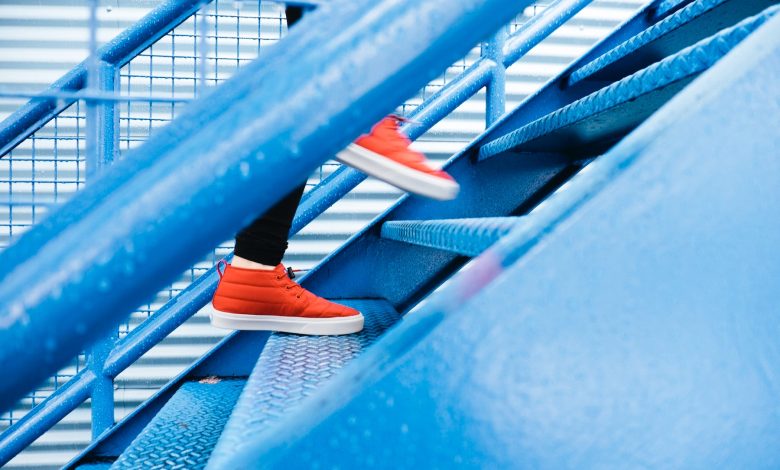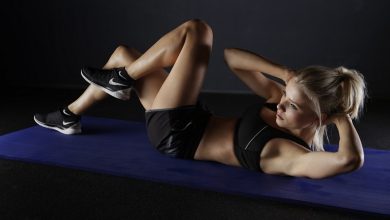Stairs Workout: 5 Best Ways to Use Stairs at Home as Exercise

An intense stairs workout might liven up your cardio regimen if it’s been feeling a little stale recently.
To combine total-body strengthening, cardio, explosive power, balance, and coordination, try a stair workout on a set of stairs in your home, apartment building, or a quiet public space. You can perform it without any additional equipment at home if you have access to stairs, which makes it a secure option in the current coronavirus pandemic. Your body weight is all you require.
Without having to visit the gym, you can get tremendous exercise by using a flight of stairs. Try a stairs workout if you’re seeking a home workout that will work out your entire body in just 15 minutes. This is best recommended if you don’t have gym equipment at home.
The Advantages of Stair Training
You already know how quickly climbing a flight of steps may raise your heart rate. But why can a stairs workout—even quick ones—feel so awfully challenging? Gravity is the simple solution.
Walking or jogging up a flight of steps puts a greater strain on your lower body’s quadriceps, glutes, hamstrings, and calves than walking or running on flat ground. Gravity is trying to pull you back down when you climb a staircase, so your muscles have to work extra hard to overcome that resistance.
It’s the same reason that travelling the same distance on a flat trail feels less intense than jogging, hiking, or bicycling up a hill.
Now let’s take a look at these five short and strong stair workouts you can do at home or even anywhere.
1. Step by Step
Want to increase your level of fitness? climb a set of steps. In comparison to walking on flat ground, you’ll increase your heart rate, burn fat, and work your glutes, hamstrings, quadriceps, and core harder. But in this case, she has developed a strategy that is perfect for folks who are just starting out with exercise. All you need is a staircase, indoors or out, with roughly 15 steps. Stretching exercises should be done right after for the optimum results to maintain your muscles fluid and prepared for the next session.
2. Various Tempos
Climb the steps carefully, keeping your shoulders back and gazing straight ahead, and then descend to get the blood circulating in your legs. Three more times, repeat. After that, sprint up the steps and then descend them. Put the majority of your weight on your heels as you descend so that your glutes, rather than your knees, will take the stress. Three more times, repeat.
3. Reverse lunge with a Step-Up
Your right leg should be on the floor behind you as you face the stairs with your left foot on the second step.
- Quickly take a step back to the starting position after lifting your right knee to your chest.
- Lunge while lowering your left leg to the floor and placing it behind your right (with your right knee directly over your ankle). Step back up quickly, bringing your left knee to your chest before going back to where you were. Perform 12 reps on one side, then 12 more on the other.
4. Triceps Step Dip
- Place your arms at your sides while sitting on the edge of the second or third step. Lift your buttocks a little bit off the step while applying pressure to your palms. Set your heels on the ground and extend your legs. Keep your feet flat on the ground and bend your legs at a 90-degree angle if you suffer from back problems.
- Slowly lower your back by 90-degree bending your arms. Returning to the beginning position, press up. Do 10 reps of this. Run up the stairs now, then take the elevator down. Take ten more dips.
5. Skater Steps
On the ground, face the stairs.
- Step onto the very left edge of the second step with your left foot.
- Continue to move your right leg in the same direction, bringing it to the far-right end of the fourth step. Take the stairs two at a time, taking them wide and keeping your head high, and continue climbing. Swing your arms and contract your abs as you go to increase calorie burn. Wander back down after you’ve gotten to the top. Do one more rep after that.
6. Mountain Climber
- With your back to the steps and your hands on the second step, keep your core tight and your arms close to your sides (essentially in a push-up position).
- Return your foot to the ground after bringing your left knee to your left shoulder. Bring your right knee to your right shoulder and then alternate legs, putting your right foot back on the ground. Do 12 repetitions without stopping. (You’ll get the sensation of sprinting in place.)
Why is a Stair Workout Effective?
You don’t always need a lot of stairs to get a good stair exercise. Simply make do with what you have. Well, if you just have a short staircase, you’ll merely use it more frequently than if it were longer.
How to Exercise on the Stairs Safely
Use particular caution when using stairs if the tread, which is the area where your foot rests, hangs over the riser (the vertical part of the step). On this kind of step, you run a higher risk of falling. Also, pay attention to where you put your feet.
Put your hand on the railing while you ascend and descend if you are new to stair workouts for added support and balance. With this additional assistance, you’ll still get a fantastic workout, and if/when you’re comfortable enough, you can transition to a hands-free technique. When performing more difficult techniques, such as the ones outlined above, it is also a good idea to lean on the railing for support.
It’s crucial to maintain mental focus while working out on stairs since, if you’re not attentive, you could trip walking up or down stairs. You do need to pay attention when you’re weary in particular, or you risk failing.
Therefore, reduce the intensity of your stair workout if your form starts to waver or you are having trouble staying balanced. For instance, if running upstairs is difficult for you, try jogging or walking instead. If you’re still having trouble, halt your stair training and either move to a flat area of the ground or call it quits for the day. You shouldn’t attempt to push through on the flight of stairs since you could really hurt yourself if you fall.
Additionally, it’s a red flag if any aspect of your stairs workout hurts (we’re talking about sharp, acute pain, not the sensation of your muscles moving). You might not be at the necessary level of fitness for the move you’re doing, you might have pushed yourself too far, or your form might be incorrect. Attempt to improve your form or regress the manoeuvre (like, switch to walking instead of jogging). If the discomfort persists, put an instant end to what you’re doing. Keep your distance from the pain. You’re rarely going to get rewarded for that.
What do you think? Would you try this type of workout? Let us know what you think about this article below in the comments!





